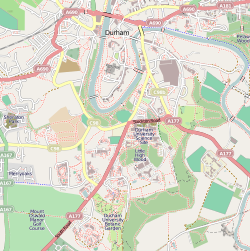
Back Дарем соборы Bashkir Дарэмскі сабор Byelorussian Дърамска катедрала Bulgarian Catedral de Durham Catalan Durhamská katedrála Czech Durham Cathedral Danish Kathedrale von Durham German Katedralo de Durham Esperanto Catedral de Durham Spanish Durhamgo katedrala Basque
| Durham Cathedral | |
|---|---|
| Cathedral Church of Christ, Blessed Mary the Virgin and St Cuthbert of Durham | |
 Durham Cathedral from the north-west | |
| 54°46′25″N 1°34′34″W / 54.77361°N 1.57611°W | |
| Location | Durham |
| Country | England |
| Denomination | Church of England |
| Previous denomination | Roman Catholic |
| Tradition | Broad church |
| Website | durhamcathedral |
| History | |
| Status | Cathedral |
| Cult(s) present | Saint Cuthbert & Saint Bede the Venerable |
| Relics held | Saints Cuthbert, Bede & Oswald |
| Architecture | |
| Functional status | Active |
| Heritage designation | Grade I listed |
| Designated | 6 May 1952[1] |
| Architectural type | Cathedral |
| Style | Norman/Romanesque, Gothic |
| Years built | 1093–1133, additions until 1490 |
| Specifications | |
| Length | 469 feet (143 m) (interior) |
| Nave width | 81 feet (25 m) (incl. aisles) |
| Nave height | 73 feet (22 m) |
| Choir height | 74 feet (23 m) |
| Number of towers | 3 |
| Tower height | 218 feet (66 m) (central tower) 144 feet (44 m) (western towers) |
| Number of spires | 0 (2 on western towers until 1658) |
| Bells | 10 (full circle) |
| Tenor bell weight | 28 long cwt 0 qr 6 lb (3,142 lb or 1,425 kg) |
| Administration | |
| Province | York |
| Diocese | Durham (since 635 as Lindisfarne, 995 as Durham) |
| Clergy | |
| Bishop(s) | Paul Butler |
| Dean | Philip Plyming |
| Precentor | Michael Hampel (vice-dean) |
| Chancellor | Charlie Allen |
| Canon(s) | Simon Oliver (professor) |
| Pastor(s) | Michael Everitt |
| Laity | |
| Director of music | Daniel Cook (organist and master of the choristers) |
| Organist(s) | Joseph Beech (sub-organist) |
| Chapter clerk | Amanda Anderson |
| Lay member(s) of chapter | Cathy Barnes Ivor Stolliday (treasurer) |
| Part of | Durham Castle and Cathedral |
| Criteria | Cultural: ii, iv, vi |
| Reference | 370 |
| Inscription | 1986 (10th Session) |
Durham Cathedral, formally the Cathedral Church of Christ, Blessed Mary the Virgin and St Cuthbert of Durham,[2] is a Church of England cathedral in the city of Durham, England. The cathedral is the seat of the bishop of Durham and is the mother church of the diocese of Durham. It also contains the shrines of the Anglo-Saxon saints Cuthbert and Bede. There are daily Church of England services at the cathedral, and it received 727,367 visitors in 2019.[3] It is a grade I listed building and forms part of the Durham Castle and Cathedral World Heritage Site.[4][5]
The cathedral is the successor to the Anglo-Saxon Lindisfarne Priory, which was established c. 635 but abandoned in 875 in the face of Viking raids. The monks settled at Chester-le-Street from 882 until 995, when they moved to Durham. The cathedral remained a monastery until it was dissolved in 1541, since when it has been governed by a dean and chapter. The cathedral precinct formed part of Durham Castle from the eleventh century. During the Wars of the Three Kingdoms the cathedral housed 3000 Scottish prisoners of war, 1,700 of whom died in the building.
The present building was substantially completed between 1093 and 1133, replacing the Anglo-Saxon 'White Church'.[6] It is a significant example of the Romanesque architectural style, and the nave ceiling is the earliest surviving example of a pointed rib vault. The Galilee chapel was added to the west end of the cathedral in the 1170s, and the western towers built in approximately 1200. The east end was expanded in the Early English Gothic style in the 1230s, and the Perpendicular Gothic central tower was built in two stages in the fifteenth century. Important furnishings include the medieval bishop's throne and Neville screen, Prior Castell's Clock, and the seventeenth-century choir stalls and font cover installed by Bishop Cosin. Many of the monastic buildings survive; the monks' refectory now contains part of the cathedral library, which holds significant collections dating back to the sixth century.[7]
- ^ "Cathedral Church of Christ and St Mary the Virgin". National Heritage List for England. Historic England. Retrieved 19 September 2022.
- ^ "Notice of Decision of Cathedrals Fabric Commission" (PDF). Church of England. 28 July 2023. Retrieved 30 November 2023.
- ^ "ALVA – Association of Leading Visitor Attractions". alva.org.uk. Retrieved 23 October 2020.
- ^ "CATHEDRAL CHURCH OF CHRIST AND ST MARY THE VIRGIN, City of Durham – 1161023 | Historic England". historicengland.org.uk. Retrieved 1 December 2023.
- ^ Historic England. "Durham Castle and Cathedral (1000089)". National Heritage List for England. Retrieved 29 October 2019.
- ^ Pevsner, Nikolaus; Metcalfe, Priscilla (2005). The Cathedrals of England: North and East Anglia. London: The Folio Society. p. 24.
Most of what makes Durham Durham is of the short space of time between 1093 and 1133, and of that phase [...]it is one of the most perfect and also historically most interesting buildings in Europe.
- ^ Cathedral, Durham. "Durham Cathedral Library". Durham Cathedral. Retrieved 1 December 2023.
